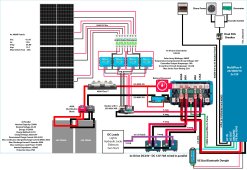gr8pix
New Member
Here is my close to final draft of the months long learning experience. I added a second 24V battery in parallel and hope my fusing is correct from the batteries to the Lynx. Should I be fusing each battery at the positive terminal as well or fusing each battery with it's own class T? Please let me know if there is anything that needs attention.

I couldn't have gotten this far without the help of this forum and the amazing dedicated people helping each other out. Thank you MisterSandals, sunshine_eggo, pvgirl just to name a few!

I couldn't have gotten this far without the help of this forum and the amazing dedicated people helping each other out. Thank you MisterSandals, sunshine_eggo, pvgirl just to name a few!



